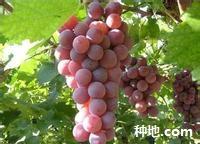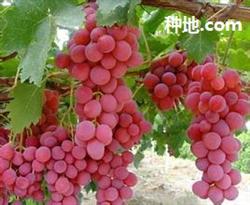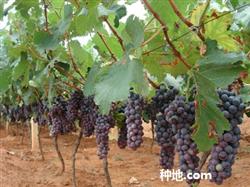How to grow ruby seedless grapes?

How to grow ruby seedless grapes? What kind of planting method is good? Ruby seedless grape has high fruit setting rate, uniform fruit grains, easy coloring, hard and crisp flesh, good flavor, early maturity and high yield, and strong adaptability. I. Basic information The experimental planting site was located in the vineyard of Huiguokou village, where the frost-free period was 232 days, the annual rainfall was 650 mm, the annual average temperature was 13.1℃, the terrain was flat, the soil was slightly alkaline, and the soil layer was deep and fertile. II. Greenhouse structure The greenhouse runs from east to west, 50 meters long, 7.5 meters wide, 3.3 meters high ridge, 1 meter high forefoot, 50 cm wide cold ditch dug at the front bottom corner, straw or wheat straw paved inside. East, west and rear walls are 50 cm hollow walls with pearlite inside. Shed a row of cement columns, column height of 2.4 meters. The upper bearing iron arch frame is covered with green non-drip film and has thermal insulation cattail curtain. A simple flue coal stove heating equipment is set up in the shed. III. Cultivation techniques 1. Planting and fertilizer and water management. Dig 30-40 cm planting holes before planting, apply 5000 kg organic fertilizer, 50 kg diammonium phosphate and 10 kg potassium sulfate per mu, mix them with soil and fill them into planting holes, then plant seedlings, irrigate enough water after planting and cover them with film to preserve moisture. 50g compound fertilizer was applied to the plants from germination to flowering, 100g compound fertilizer was applied to the shoots when they grew to 40cm, 400-fold paclobutrazol was sprayed when they were 1 meter tall, fertilizer and water were stopped in the middle of July, 0.3% potassium dihydrogen phosphate was sprayed from fruit setting to berry coloring, and 5000kg organic decomposed chicken manure was continuously applied after fruit picking. In early October, water was irrigated enough, and in late November, the shed was heated up and water was irrigated for germination. 2. Shaping and pruning. The seedlings were pruned with single dragon stem type after planting. Each plant had a main vine with 4-6 fruiting branches and no fruiting branch group. When growing to 30 cm, the frame is tied and the accessory shoots in the leaf axils are removed. When the new shoots grow to 1 m, spray paclobutrazol on the main vine, and when they grow to 2.5 m, remove the top, leave 2 -3 auxiliary shoots on the top, and leave 2-3 leaves on each shoot. Leave a 60-80 cm short section before buckling. After heating, 5 shoots were reserved and the rest were removed. When the new shoots grow to 20 cm first, do twisting-shoot treatment, control the growth, 10 -15 days later, when the new shoots grow to 20 cm, do toppling treatment. When growing to 30-40 cm, pull the strong shoots to less branches with ropes, so that the fruit branches are evenly distributed. To be sent out of the secondary shoot only 1-2, 2-4 leaves per shoot. 3, temperature and humidity control. October 19-20, buckle film, cover the grass in the daytime so that indoor light, open the tuyere ventilation at night, so that the temperature is reduced to outdoor temperature, cold for 30 days. The mother branch was wiped with lime nitrogen solution to release dormancy ahead of time. In the middle and late November, the temperature was raised during the day, and the temperature was kept at 18℃ at night from germination to flowering, 25-28℃ during the day, 15-18℃ at night during flowering, and 30℃ during the day. The optimum temperature is 25-28℃, the night temperature is 20℃ during the expansion stage of young fruit, and then it is controlled at 18-20℃, 25 - 28 ℃ during the day, 25- 28℃ during the coloring stage, and 16-18℃ at night. Always pay attention to the temperature inside the shed, turn on the heating equipment when it is too low, and keep the temperature inside the shed. The relative humidity can be controlled at 85- 90%, 60- 70%, 60%, 50- 60% and 60- 70% during germination, flowering, fruit expansion and coloring stages respectively. Cover early and late, increase lighting time, use light to supplement light on cloudy and snowy days, and hang reflective curtains indoors. Remove dust and debris from the film at any time to increase illumination. When the carbon dioxide content decreases, increase the application of solid carbon dioxide fertilizer. 4. Flower and fruit management. Weak branches remain, strong branches leave an ear, thinning out the accessory ear, pinching the ear head, leaving 5 ears per plant, thinning out small grains, dense grains. Spray 0.3% potassium dihydrogen phosphate when berries are colored. 5. Disease and pest control. Spraying Bome 5 degree sulfur mixture before closing the shed, the early growth stage of new shoots is the lowest temperature period of the whole year, easy to suffer from gray mold and downy mildew, ecological method of variable temperature management should be adopted, according to the temperature and humidity requirements of each stage to adjust well. Chemical control by smoke method, dust method rotation application, once a week. Attention should be paid to whitefly control, cyhalothrin spray 25% EC. Fruit growth period to prevent downy mildew and powdery mildew, which is very easy to occur in the shed disease, available chlorothalonil fumigant, 16% anti-frost dust agent, 7 -10 days fumigation 1. Also available 46% aluminum triethyl phosphate plus 15% triadimefon 2000 times solution. After fruit picking, spray 200 times of Bordeaux mixture, once a half month, to protect the leaves. Click to see more grape growing technology Click to see more fruit growing technology
- Prev

How to manage the red earth grape flowers and fruits?
How to manage the red earth grape flowers and fruits? Red Earth grape flower and fruit stage can be managed like this: first, the role through flower and fruit management, control the size of grape ear. By removing the accessory ear and pinching the ear tip, it can save nutrients, reduce the fruit thinning workload, increase the fruit setting rate, increase the fruit, and improve the fruit quality. Pass.
- Next

How can black grapes be planted with high yield?
How to plant black grapes to get high yield? American black grape (black big grain and Rebel two varieties), panicle weight 500-700g, conical, grain weight 10-12g, peel thick, black, tough, pulp hard and crisp, juice purplish red, contains 18% soluble solids, extremely sweet, excellent quality. From bud to fruit.
Related
- Moge, come on! The staff of the peasant association in the producing area of cantaloupe were frightened when the crowd gathered.
- Causes and Solutions of low Fruit setting rate of Apple
- Symptoms and control measures of passion fruit virus disease
- Fruit growing lesson: how do apple orchards keep high yields?
- Can you build orchards in the mountains? What are the pros and cons?
- How to manage the coloring period of Crisson grape?
- This paper introduces the processing technology of two kinds of fig products.
- How much is a month for retired teachers in rural areas by 2020?
- How can strawberry planting increase sugar content? We should pay attention to management in many aspects.
- What are the cultivation techniques on how to improve the yield of golden fruit?

